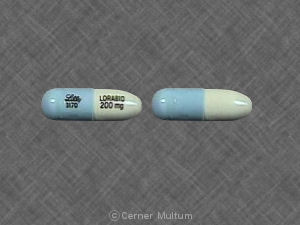Lorabid Pulvules Interactions
There are 46 drugs known to interact with Lorabid Pulvules (loracarbef), along with 4 disease interactions, and 1 alcohol/food interaction. Of the total drug interactions, 6 are major, and 40 are moderate.
- View all 46 medications that may interact with Lorabid Pulvules
- View Lorabid Pulvules alcohol/food interactions (1)
- View Lorabid Pulvules disease interactions (4)
Most frequently checked interactions
View interaction reports for Lorabid Pulvules (loracarbef) and the medicines listed below.
- Abilify MyCite (aripiprazole)
- Actemra (tocilizumab)
- Adcetris (brentuximab)
- Adcirca (tadalafil)
- Adempas (riociguat)
- Adriamycin (doxorubicin)
- Advair Diskus (fluticasone / salmeterol)
- Afinitor Disperz (everolimus)
- Afstyla (antihemophilic factor)
- Aggrenox (aspirin / dipyridamole)
- Akynzeo (netupitant / palonosetron)
- Aldurazyme (laronidase)
- Alimta (pemetrexed)
- Alprazolam Intensol (alprazolam)
- Amicar (aminocaproic acid)
- amoxicillin
- Apresazide (hydralazine / hydrochlorothiazide)
- Aptivus (tipranavir)
- Arava (leflunomide)
- Aricept (donepezil)
- Arzerra (ofatumumab)
- Asendin (amoxapine)
- Atarax (hydroxyzine)
- ATNAA (atropine / pralidoxime)
- Atripla (efavirenz / emtricitabine / tenofovir disoproxil)
- Atrovent (ipratropium)
- Aubagio (teriflunomide)
- Austedo (deutetrabenazine)
- Avandia (rosiglitazone)
- Avastin (bevacizumab)
Lorabid Pulvules alcohol/food interactions
There is 1 alcohol/food interaction with Lorabid Pulvules (loracarbef).
Lorabid Pulvules disease interactions
There are 4 disease interactions with Lorabid Pulvules (loracarbef) which include:
More about Lorabid Pulvules (loracarbef)
- Lorabid Pulvules consumer information
- Compare alternatives
- Drug images
- Side effects
- Dosage information
- During pregnancy
- Drug class: second generation cephalosporins
- Breastfeeding
Related treatment guides
Drug Interaction Classification
| Highly clinically significant. Avoid combinations; the risk of the interaction outweighs the benefit. | |
| Moderately clinically significant. Usually avoid combinations; use it only under special circumstances. | |
| Minimally clinically significant. Minimize risk; assess risk and consider an alternative drug, take steps to circumvent the interaction risk and/or institute a monitoring plan. | |
| No interaction information available. |
See also:
Further information
Always consult your healthcare provider to ensure the information displayed on this page applies to your personal circumstances.


